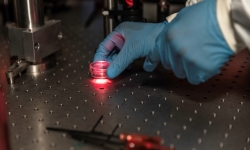CSIR method of using optical techniques to diagnose deadly viruses published for the first time
The CSIR’s Dr Patience Mthunzi-Kufa is leading the charge in developing laser-based diagnostic tools to detect HIV and tuberculosis, as well as to screen for substandard medicine. As research group leader of the CSIR’s biophotonics group, Mthunzi-Kufa led the team whose research has now been published in the Journal of Biophotonics and cited in the Advanced Science News, an online library that highlights new and exciting developments from across a broad spectrum of scientific disciplines.
The CSIR’s Dr Patience Mthunzi-Kufa is leading the charge in developing laser-based diagnostic tools to detect HIV and tuberculosis, as well as to screen for substandard medicine. As research group leader of the CSIR’s biophotonics group, Mthunzi-Kufa led the team whose research has now been published in the Journal of Biophotonics and cited in the Advanced Science News, an online library that highlights new and exciting developments from across a broad spectrum of scientific disciplines.
In a paper titled, “Label‐free differentiation of human immunodeficiency virus‐1 infected from uninfected cells using transmission measurement,” the CSIR group has reported on a label-free optical method for real-time detection of HIV. Dr Mthunzi-Kufa says the research was inspired by the current challenges faced in accurately diagnosing patients. “Many people do not get treatment because they don’t get diagnosed properly or timeously. By the time a patient is diagnosed, the disease has progressed significantly. Our aim is to advance research that will aid efficient diagnosis and ultimately lead to better medical interventions.”
The team utilises HIV-1 infected cells, applies different laser-based methodologies, including transmission spectroscopy, to analyse the cells and compare them to uninfected cells. The research found that the two cell populations expressed different spectra when analysed through laser techniques, which is a novel approach compared to conventional methods of manipulating or tagging the infected cells. Patent applications have been filed and the work has been published in the Journal of Biophotonics, which led to the research being cited on Advanced Science News. The feature has increased the profile of the group both internationally and locally.
Mthunzi-Kufa was recently appointed as honorary research fellow in the School of Chemistry and Physics at the University of KwaZulu-Natal, and will be mentoring a new crop of biophotonics specialists. Biophotonics investigates the development and application of optical or photonics-based techniques to facilitate single molecule and/or cell studies. It is a multidisciplinary, directed research field that cuts across various scientific disciplines, including biological sciences, medicine, chemistry and physical sciences.



